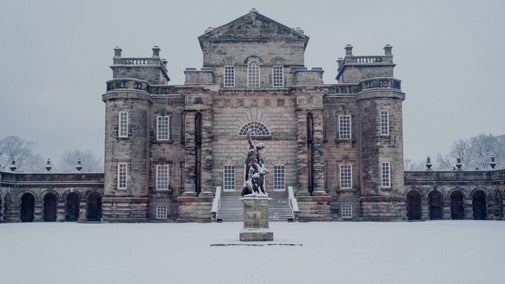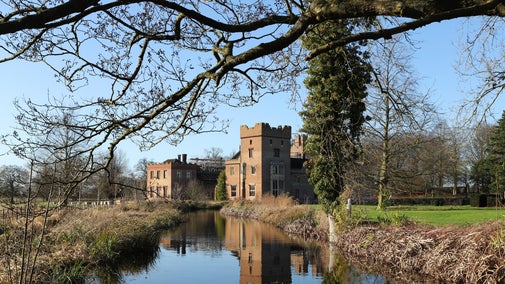
Donate
Everyone needs nature, now more than ever. Donate today and you could help people and nature to thrive at the places we care for.

Since the National Trust acquired Seaton Delaval Hall in 2009, conservation has been one of our top priorities. Find out more about restoration projects from our first 10 years of caring for the hall below, from restoring the weather-damaged marble floor to adding a brand new cornerstone.
In 2026 we’ll celebrate the life of Sir John Vanbrugh, Seaton Delaval Hall’s renowned architect, marking the tercentenary of his life. Together with five of his other most notable properties - Castle Howard, Blenheim Palace, Grimsthorpe Castle, Kimbolton Castle and Stowe House - we’ll present a series of events, exhibitions and activities across the year. Vanbrugh 300 is presented by The Georgian Group and funded by the National Lottery Heritage Fund. Find out more about Vanbrugh 300.
Look up to the upper arcades of the Entrance Hall and you will see six figures set into the recesses of the stonework. Representing architecture, painting, music, sculpture, geography, these six 18th-century stucco statues were in need of significant conservation work after they'd been shot at, burned in a fire and weathered by the elements.
The figures are of an unusual construction, beginning with shaped iron pieces which were covered with tiles, brick and plaster to form the shape of a mannequin, followed by muslin covered in layers of stucco plaster, giving the statues a very realistic and lifelike appearance.
It was generally assumed that the fire of 1822 caused the damage to the statues. In fact, it appears to have been a result of the 40 years of exposure to the elements following the fire when the hall was left without a roof.
Several layers of dust, dirt and even birds' nests were removed from the statues so that each one could be individually assessed. At least two of the statues also bore the scars of having been shot at during some point in their history!
The statues’ restoration required an expert, and one was found in the form of sculpture conservationist Graciela Ainsworth.

Along with her team, Graciela spent weeks teetering on 10-metre high scaffolding working her magic on the muses, along with stone and plaster specialist Trevor Proudfoot plus a local vet, Stephen Bradley, who brought along his portable x-ray equipment to help check the statues’ inner iron framework.
The emergency conservation work was a success. Read more about Graciela Ainsworth at her website: www.graciela-ainsworth.com.
The disastrous fire of 1822 left the Central Hall roofless and open to the elements for 40 years, and the black and white tiled floor bore the brunt of that damage.
With the slabs unstable and loose, so much so that every time they were walked on there was risk of them moving against each other and chipping the edges, this was an essential restoration project for the Trust’s early years at the Hall.

Following extensive surveys of the Entrance Hall and thanks to support from the Sita Trust, the conservation team carefully numbered, plotted the position of and lifted every black and white slab from the floor. Once lifted, all the numerous cracked and shattered slabs were painstakingly bonded together again using conservation-grade resin adhesives mixed with pigment and stainless steel dowels added to give them strength.
The original three layers of screed have been replaced where they had been weathered to nothing, and the floor re-laid, with each slab returned to its original position. The final work was replacing those that were too badly damaged to be retained, using Carrera marble and black limestone that closely match the originals.
On the north side of the Central Hall, at the top of one of the columns, is a beautiful brand-new piece of stone.
The original stone had to be replaced as it was so badly cracked and broken that it was unsafe.
Locally sourced to match, the new addition was carved and fitted on-site by specialist stone masons, using a huge crane to carefully lift the tonne weight into place.
It matches perfectly, and was the last piece to be fitted before the scaffolding on the Central Hall could be taken down.
With your ongoing support, we're able to continue our vital conservation work. Thank you for helping to protect these special places.

Everyone needs nature, now more than ever. Donate today and you could help people and nature to thrive at the places we care for.
Learn the story of this baroque Northumberland manor house and the individuals who shaped it, including architect Sir John Vanbrugh and the notorious 18th-century Delaval family.

Find out more about the major conservation work at Seaton Delaval Hall and discover new facilities, experiences and events thanks to the National Lottery Heritage Fund.
Uncover centuries of history and the story of the flamboyant and theatrical 'gay Delavals' in architect Sir John Vanbrugh's stunning buildings at Seaton Delaval Hall. Discover the dramatic scars of the fierce fires that nearly condemned it to ruin 200 years ago and see how the creativity and mischief has returned to this country house once more.

Find out what you’ll discover this season in the varied garden at Seaton Delaval Hall, one of Northumberland's top gardens. From a Parterre to a centuries-old weeping ash and woodland waiting to be explored.

Read about our strategy, which focuses on restoring nature, ending unequal access and inspiring more people.

We believe that nature, beauty and history are for everyone. That’s why we’re supporting wildlife, protecting historic sites and more. Find out about our work.
